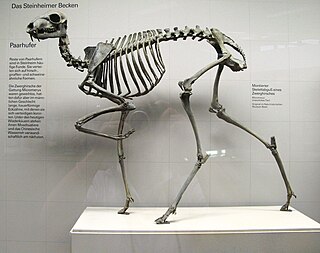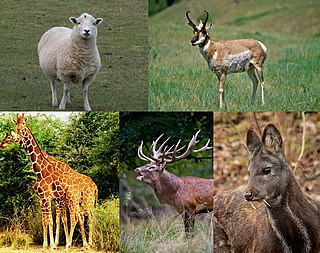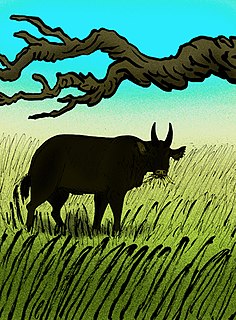
The subfamily Caprinae is part of the ruminant family Bovidae, and consists of mostly medium-sized bovids. A member of this subfamily is called a caprine, or, more informally, a goat-antelope.

The Bovidae comprise the biological family of cloven-hoofed, ruminant mammals that includes cattle, bison, buffalo, antelopes, and goat-antelopes. A member of this family is called a bovid. With 143 extant species and 300 known extinct species, the family Bovidae consists of eight major subfamilies apart from the disputed Peleinae and Pantholopinae. The family evolved 20 million years ago, in the early Miocene.

Moschidae is a family of pecoran even-toed ungulates, containing the musk deer (Moschus) and its extinct relatives. They are characterized by long 'saber teeth' instead of horns, antlers or ossicones, modest size and a lack of facial glands. The fossil record of the family extends back to the late Oligocene, around 28 million years ago. The group was abundant across Eurasia and North America during the Miocene, but afterwards declined to only the extant genus Moschus by the early Pleistocene.

Musk deer can refer to any one, or all seven, of the species that make up Moschus, the only extant genus of the family Moschidae. Despite being commonly called deer, they are not true deer belonging to the family Cervidae but rather their family is closely related to Bovidae, the group that contains antelopes, bovines, sheep and goats. The musk deer family differs from cervids, or true deer, by lacking antlers and preorbital glands also, possessing only a single pair of teats, a gallbladder, a caudal gland, a pair of canine tusks and—of particular economic importance to humans—a musk gland.

The four-horned antelope, or chousingha, is a small antelope found in India and Nepal. Its four horns distinguish it from most other bovids, which have two horns. The sole member of the genus Tetracerus, the species was first described by French zoologist Henri Marie Ducrotay de Blainville in 1816. Three subspecies are recognised. The four-horned antelope stands nearly 55–64 centimetres (22–25 in) at the shoulder and weighs nearly 17–22 kilograms (37–49 lb). Slender with thin legs and a short tail, the four-horned antelope has a yellowish brown to reddish coat. One pair of horns is located between the ears, and the other on the forehead. The posterior horns are always longer than the anterior horns, which might be mere fur-covered studs. While the posterior horns measure 8–12 centimetres (3.1–4.7 in), the anterior ones are 2–5 centimetres (0.79–1.97 in) long.

Tragelaphus is a genus of medium- to large-sized spiral-horned antelopes. It contains several species of bovine, all of which are relatively antelope-like. Species in this genus tend to be large sized, lightly built, have long necks and considerable sexual dimorphism. Elands, including the common eland, are embedded within this genus meaning that Taurotragus must be subsumed into Tragelaphus to avoid paraphyly. Alternatively, Taurotragus could be maintained as a separate genus, if the nyala and the lesser kudu are relocated to their own monospecific genera: respectively, Nyala and Ammelaphus. Other generic synonyms include Strepsiceros and Boocercus. The name "Tragelaphus" comes from the mythical tragelaph.

The subfamily Reduncinae is composed of nine species of antelopes, all of which dwell in marshes, floodplains, or other well-watered areas, including the waterbucks and reedbucks. These antelopes first appear in the fossil record 7.4 million years ago in Eurasia and 6.6 Mya in Africa.

Capra is a genus of mammals, the goats, composed of up to nine species, including the markhor and many species known as ibexes. The domestic goat is a domesticated species derived from the wild goat. Evidence of goat domestication dates back more than 8,500 years.

The Antilopinae are a subfamily of Bovidae. The gazelles, blackbucks, springboks, gerenuks, dibatags, and Central Asian gazelles are often referred to as true antelopes, and are usually classified as the only representatives of the Antilopinae. True antelopes occur in much of Africa and Asia, with the highest concentration of species occurring in East Africa in Sudan, Eritrea, Ethiopia, Somalia, Kenya, and Tanzania. The saigas and Tibetan antelopes are related to true antelopes (Antilopinae) and goats (Caprinae), but often placed in their own subfamily, Saiginae. These animals inhabit much of central and western Asia. The dwarf antelopes are sometimes placed in a separate subfamily, Neotraginae, and live entirely in sub-Saharan Africa. The antilopinae are a subfamily of bovidaes that roam the East African savannas, they have acclimated to possess wider insertion muscles to enable them to avoid predators in the open savanna.

Aepyceros is a genus of African antelope that contains a single living species, the impala.

Soemmerring's gazelle, also known as the Abyssinian mohr, is a gazelle species native to the Horn of Africa. The species was described and given its binomen by German physician Philipp Jakob Cretzschmar in 1828. Three subspecies are recognized. It is possibly no longer present in Sudan.

Pecora is an infraorder of even-toed hoofed mammals with ruminant digestion. Most members of Pecora have cranial appendages projecting from their frontal bones; only two extant genera lack them, Hydropotes and Moschus. The name “Pecora” comes from the Latin word pecus, which means “horned livestock”. Although most pecorans have cranial appendages, only some of these are properly called “horns”, and many scientists agree that these appendages did not arise from a common ancestor, but instead evolved independently on at least two occasions. Likewise, while Pecora as a group is supported by both molecular and morphological studies, morphological support for interrelationships between pecoran families is disputed.

Hippotragus is a genus of antelopes which includes two living and one recently extinct species, as well as some fossil relatives. The name comes from Greek ἵππος (híppos), "horse", and τράγος (trágos), "he-goat".

The tribe Bovini, or wild cattle are medium to massive bovines that are native to North America, Eurasia, and Africa. These include the enigmatic, antelope-like saola, the African and Asiatic buffalos, and a clade that consists of bison and the wild cattle of the genus Bos. Not only are they the largest members of the subfamily Bovinae, they are the largest species of their family Bovidae. The largest species is the gaur, weighing up to 1,500 kg (3,300 lb).

Boselaphini is a tribe of antelopes belonging to the subfamily Bovinae of the family Bovidae. It contains only two extant genera.

Zenkerella is a genus of rodent, the only member of the family Zenkerellidae. It was formerly classified in Anomaluridae until phylogenetic studies made its distinctiveness clear.

Ugandax is an extinct genus of bovines in the subtribe Bubalina that lived from the Miocene to the Pleistocene of Africa. Cladistic analyses suggest Ugandax represents an ancestral form of the African buffalo, Syncerus, and teeth assigned to Ugandax represent the earliest appearance of bovines in Africa.

Saigini is a tribe of artiodactyl mammals of the Bovidae family, subfamily Antilopinae, comprising two species of medium-sized gazelles that inhabit the Eurasian steppes.

Goat evolution is the process by which domestic goats came to exist through evolution by natural selection. Wild goats were one of the first species domesticated by modern humans, with the date of domestication generally considered to be 8,000 BCE. Domestic goats are medium-sized mammals which are found in noticeably harsh environments, particularly forest and mountains, in the Middle east and Central Asia, covering an area from Turkey to Turkmenistan. Goats are part of the family Bovidae, a broad and populous group which includes a variety of ruminants such as bison, cows and sheep. Bovids all share many traits, such as hooves and a herbivorous diet and all males, along with many females, have horns. Bovids began to diverge from deer and giraffids during the early Miocene epoch. The subfamily Caprinae, which includes goats, ibex and sheep, are considered to have diverged from the other bovidae as early as the late Miocene, with the group reaching its greatest diversity in the ice ages.
Numidocapra is an extinct genus of bovid from the Pleistocene of Africa.



















